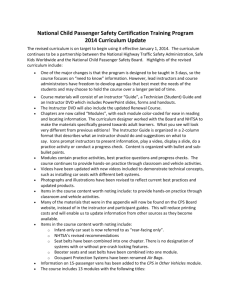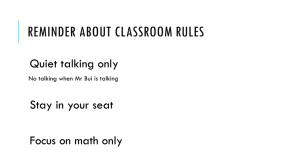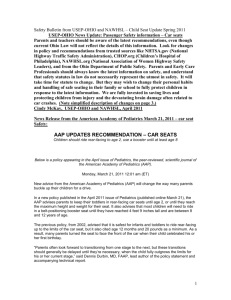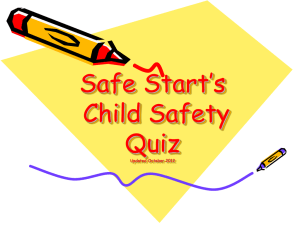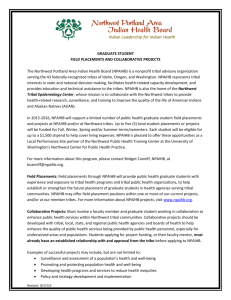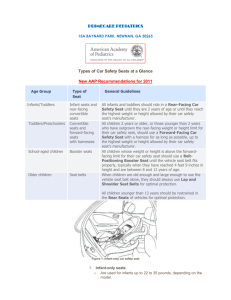2013 Risky Business_Injury Prevention Presentation
advertisement
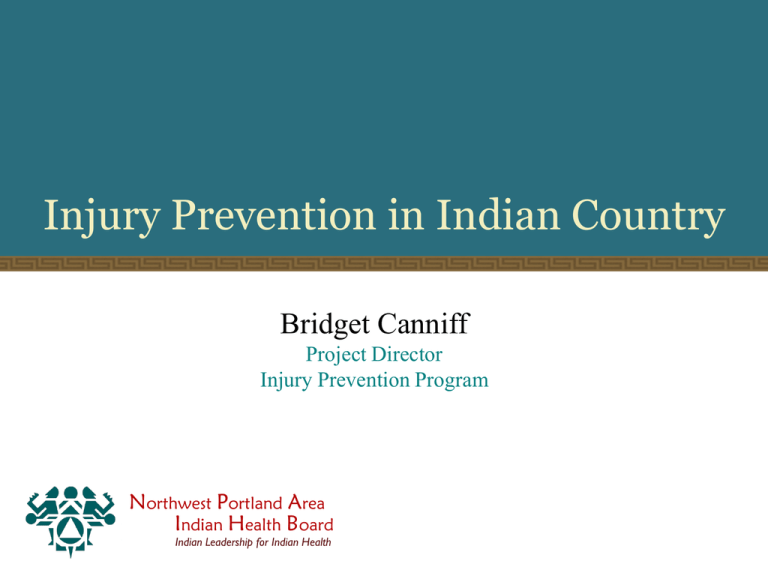
Injury Prevention in Indian Country Bridget Canniff Project Director Injury Prevention Program Northwest Portland Area Indian Health Board Indian Leadership for Indian Health What is Injury? Damage or harm caused to the body by an outside agent or force Unintentional Injury (aka “Accidents”) unplanned/unexpected events (most falls, motor vehicle crashes, drowning, burns, etc.) Intentional Injury self-inflicted violence (suicide/attempt) assault, domestic violence, homicide Injuries are NOT accidents! They are NOT random, unavoidable events They occur in predictable patterns They are associated with risk factors Most are preventable What is Injury Prevention? Efforts to prevent or reduce the severity of injuries before they occur Programs which advance the health of the population by preventing injuries and improving quality of life Key Unintentional Injury Topics Motor Vehicle Safety Seat Belts, Child Safety Seats, Impaired or Distracted Driving Prevention Elder Falls Prevention Poisoning Prevention Home Safety & Fire Prevention Bike Safety & Helmet Use Water Safety & Drowning Prevention Firearms Safety Buckle up those you love and for those who love you Motor Vehicle Safety Seat Belts and Child Safety Seats Motor Vehicle Safety What things can help improve safety on the road? What can we do to prevent crashes and reduce injury from crashes? Motor Vehicle Safety • Ensure vehicles are safe and in working order • Promote restraint use for all ages • Discourage aggressive / distracted driving • Enforcement of laws • Provide community education • Change societal attitudes “We Don’t Buckle Up!” WHY? “We don’t get tickets on the Rez.” “I am only going down the street.” “I just don’t think about it.” “He’ll stop crying if I hold him in my lap.” “She thinks she’s too old.” 5 Ways Seat Belts and Child Safety Seats Prevent Injury 1. 2. 3. 4. 5. Help the body slow down Contact the strongest parts of the body Spread forces over a wide area of the body Protects the brain, spinal cord, & for kids, abdomen Keep adults and children in the vehicle 4 Steps for Kids 1. Rear-facing 2. Forward-facing 3. Booster seats 4. Adult seat belts Step 1 Rear-Facing Infant Seats ■ ■ At minimum: Keep infants rear-facing until 1 year and 20 lbs Recommended: until 2 years Steps 1 & 2 Rear-Facing / Forward-Facing Convertibles ■ Reclined for rearfacing and upright for forward-facing Step 2 Forward-Facing Child Seats Follow recommendation for specific seat Step 3 Booster Seats ■ Booster seats are for children from 40 to High back booster 80/100 pounds ■ Lap/shoulder belt only ■ Head restraint ■ Use shoulder belt positioners Belt-positioning backless booster Step 4 Seat Belts ■ Vehicle seat belts are made for adults and older children 4’9” or taller ■ Most children reach this height at 8 years old and 80+ pounds ■ All children under the age of 13 should still sit in the back seat Incorrect Restraint Use • Children using adult seat belt face 3.5 times greater risk for serious injury • 51-82% of infant car seats and 30% of booster seats are used incorrectly • incorrect installation • incompatible with child’s height, weight, or age • straps are too loose Seat Belts & Child Safety Seats • Does your tribe have current laws for on reservation belt/safety seat use, or follow state law? • What do the laws mandate? • What are your impressions of community compliance with state or tribal laws? The Message for Native Communities ■ Wearing a seat belt and keeping children in safety seats is the easiest way to prevent injury or death ■ It only takes a few seconds – you never know when you may be in a crash ■ Buckle up for every ride, even short trips Interventions • Community Education • Enact and enforcement of restraint laws • Educating Head Starts, daycares, schools and health care providers • Encouraging Tribal leaders and elders to spread the message Interventions • Car seat distribution programs and checks • Certified Child Passenger Safety (CPS) technicians • Working with car manufacturers and car seat designers on compatibility Motor Vehicle Safety Resources • NPAIHB IP Program Luella Azule, IP Coordinator & CPS Technician lazule@npaihb.org 503-416-3263 • National Highway Traffic Safety Administration www.nhtsa.gov • Washington Safety Restraint Coalition www.800bucklup.org • Washington State Booster Seat Coalition www.boosterseat.org Elder Safety and Falls Prevention Impact of Elder Falls • In the Northwest, falls are responsible for up to 25% of unintentional injury deaths for American Indians/Alaska Natives aged 55 and over Source: Centers for Disease Control and Prevention, National Center for Injury Prevention and Control. Web-based Injury Statistics Query and Reporting System (WISQARS) [online]. (1999-2007) [cited Feb 18 2009]. Available from URL: www.cdc.gov/ncipc/wisqars Proven Interventions • • • • • Comprehensive check-ups Medication management Vision care Make home safe Regular exercise for balance & strength Elder Falls Resources • NPAIHB IP Website www.npaihb.org/epicenter/project/ injury_prevention_program • Fall Prevention Center of Excellence (CA) www.stopfalls.org • CDC National Center for Injury Prevention and Control www.cdc.gov/homeandrecreationalsafety/falls Poisoning Prevention Poisoning Prevention • Household chemicals and poisons • Lead • Carbon monoxide • Medications and drugs Interventions • Keep cleaning products and chemicals out of children’s reach • Test for lead paint • Install carbon monoxide detectors • Lock up medications Poisoning Resources • Lock Your Meds www.lockyourmeds.org • Take Back Your Meds (WA) www.takebackyourmeds.org • CDC Healthy Homes – Poisoning Prevention www.cdc.gov/healthyhomes/bytopic/ poisoning.html Community Injury Prevention Priorities & Partnerships • What injury prevention efforts are priorities for YOUR tribal communities? • Who is involved, or could be involved? • Needs? Interests? Goals? Resources? Public Health Approach Define the Problem -Surveillance Implement & Evaluate Programs -Prevention Identify Risk Factors -Who, What? Find what Prevents the Problem -What Works? Adapted from National Center for Injury Prevention and Control, CDC Assess the Need in Your Community • Who is being injured? Where? Circumstances? • How? How many? How serious? • What time period? Increasing or decreasing in frequency? • Which of these injuries is most significant in terms of: personal impact economic costs social consequences Assess the Need in Your Community • Local injury rates: higher/lower than national/state rates? How does it compare to other health problems? • Community issues (cultural, attitudes, beliefs, behaviors) contributing to injuries? • How to decreasing injuries? Proven/effective strategies? • Community strengths (cultural, attitudes, beliefs, behaviors) to reduce injuries? • What’s needed to evaluate an intervention? Injury Prevention Resources • NPAIHB Injury Prevention Program www.npaihb.org/epicenter/project/ injury_prevention_program • CDC National Center for Injury Prevention and Control (NCIPC) www.cdc.gov/injury Injury Prevention Contacts Luella Azule (Yakama Nation/Umatilla) Injury Prevention Coordinator 503-416-3263 lazule@npaihb.org Bridget Canniff Project Director, Injury Prevention Program 503-416-3302 bcanniff@npaihb.org Questions? Thank you!
